Health Promotion Strategies for ATSI Communities: An Overview
VerifiedAdded on 2023/01/06
|5
|846
|60
Report
AI Summary
This report focuses on health promotion strategies for Aboriginal and Torres Strait Islander (ATSI) communities, emphasizing the importance of culturally safe care practices and effective cross-cultural communication. It addresses the significant health disparities faced by these communities, including respiratory diseases, diabetes, and cancer, and highlights the need for tailored interventions. The report discusses various government and healthcare initiatives, such as cultural continuity and healing programs and the Indigenous Hip Hop Program, aimed at improving mental and physical well-being. It underscores the significance of health promotion activities in raising awareness and empowering ATSI people to manage their health and minimize physical risks. The report references several academic sources to support its findings, providing a comprehensive overview of the challenges and potential solutions in promoting health within these communities.
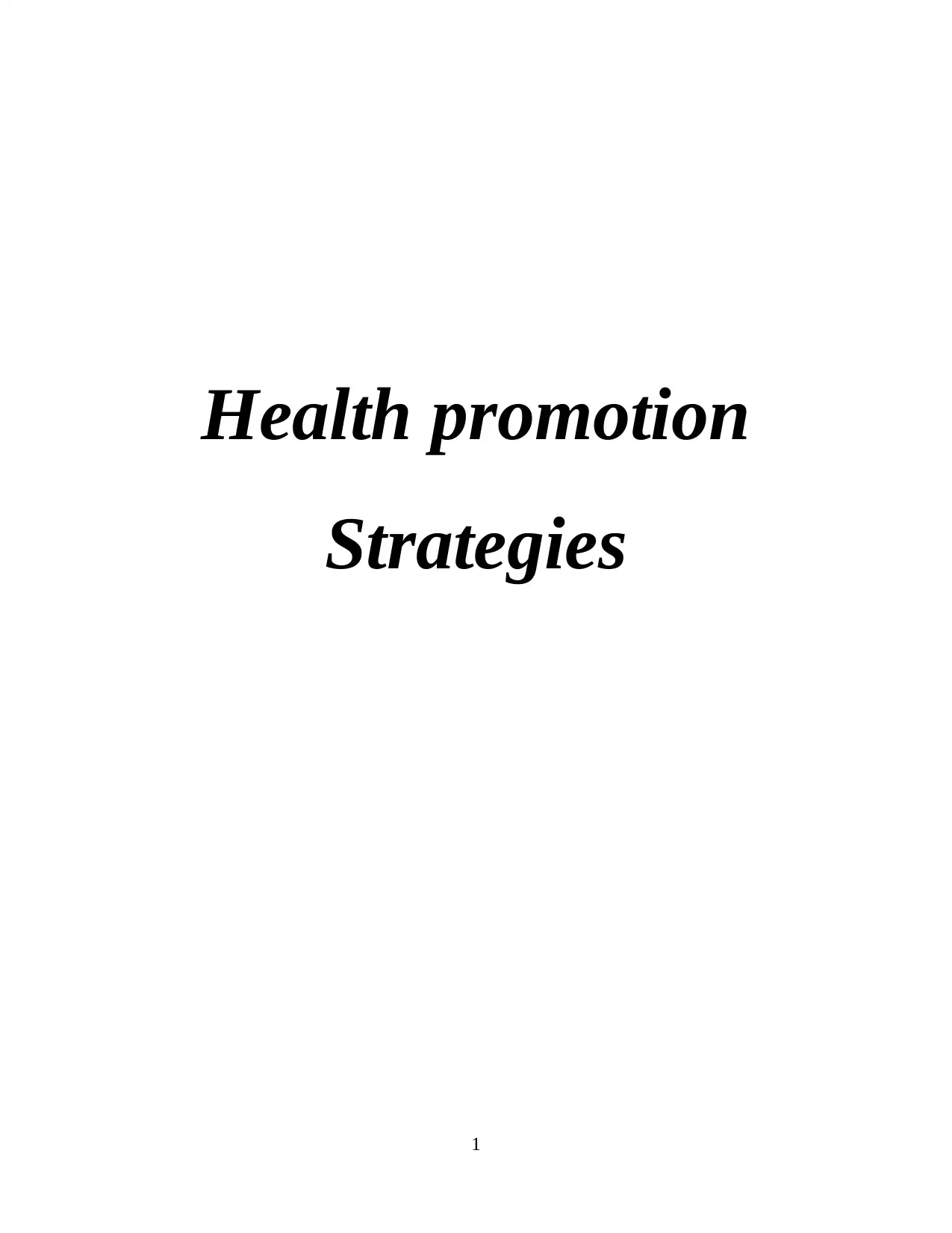
Health promotion
Strategies
1
Strategies
1
Paraphrase This Document
Need a fresh take? Get an instant paraphrase of this document with our AI Paraphraser
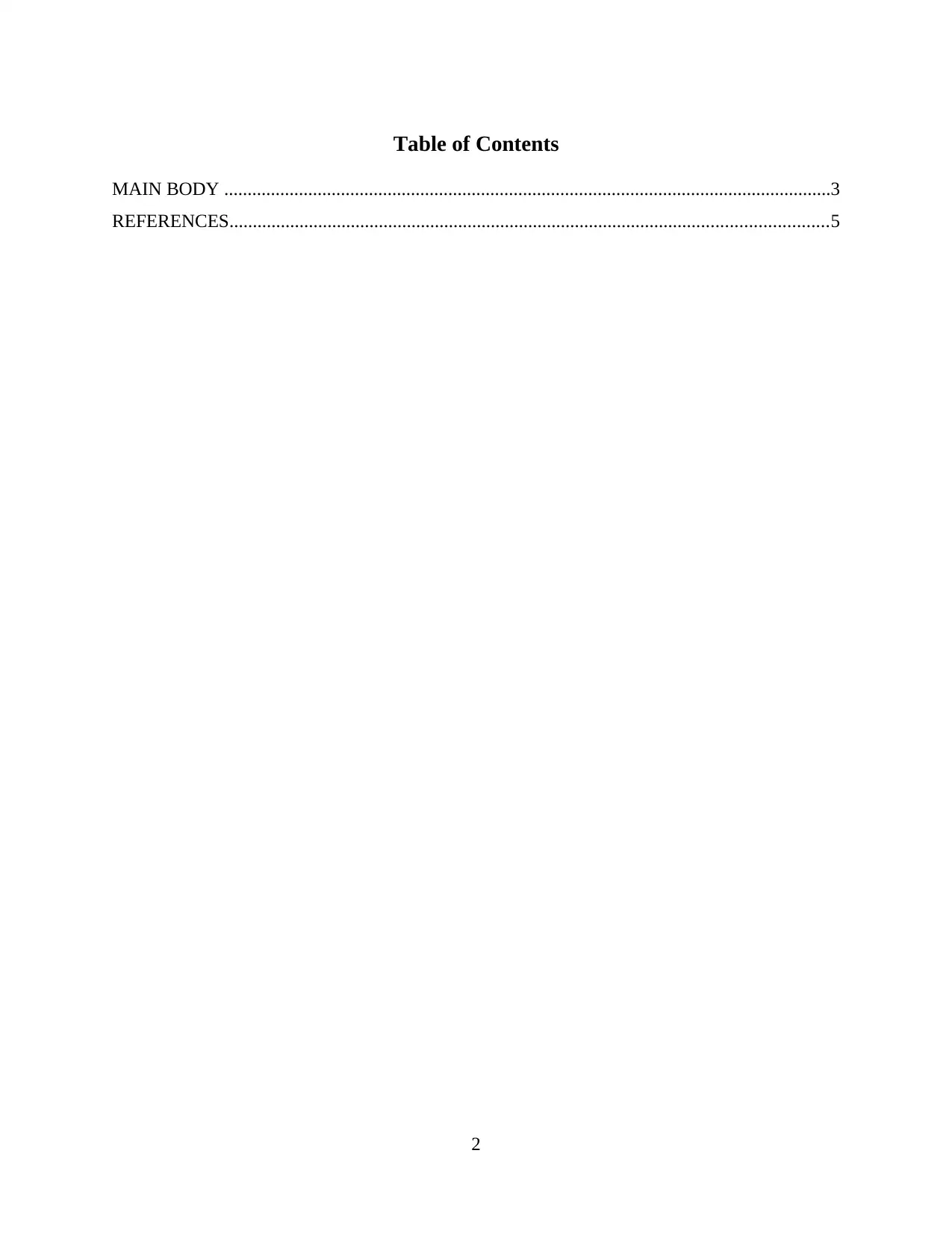
Table of Contents
MAIN BODY ..................................................................................................................................3
REFERENCES................................................................................................................................5
2
MAIN BODY ..................................................................................................................................3
REFERENCES................................................................................................................................5
2
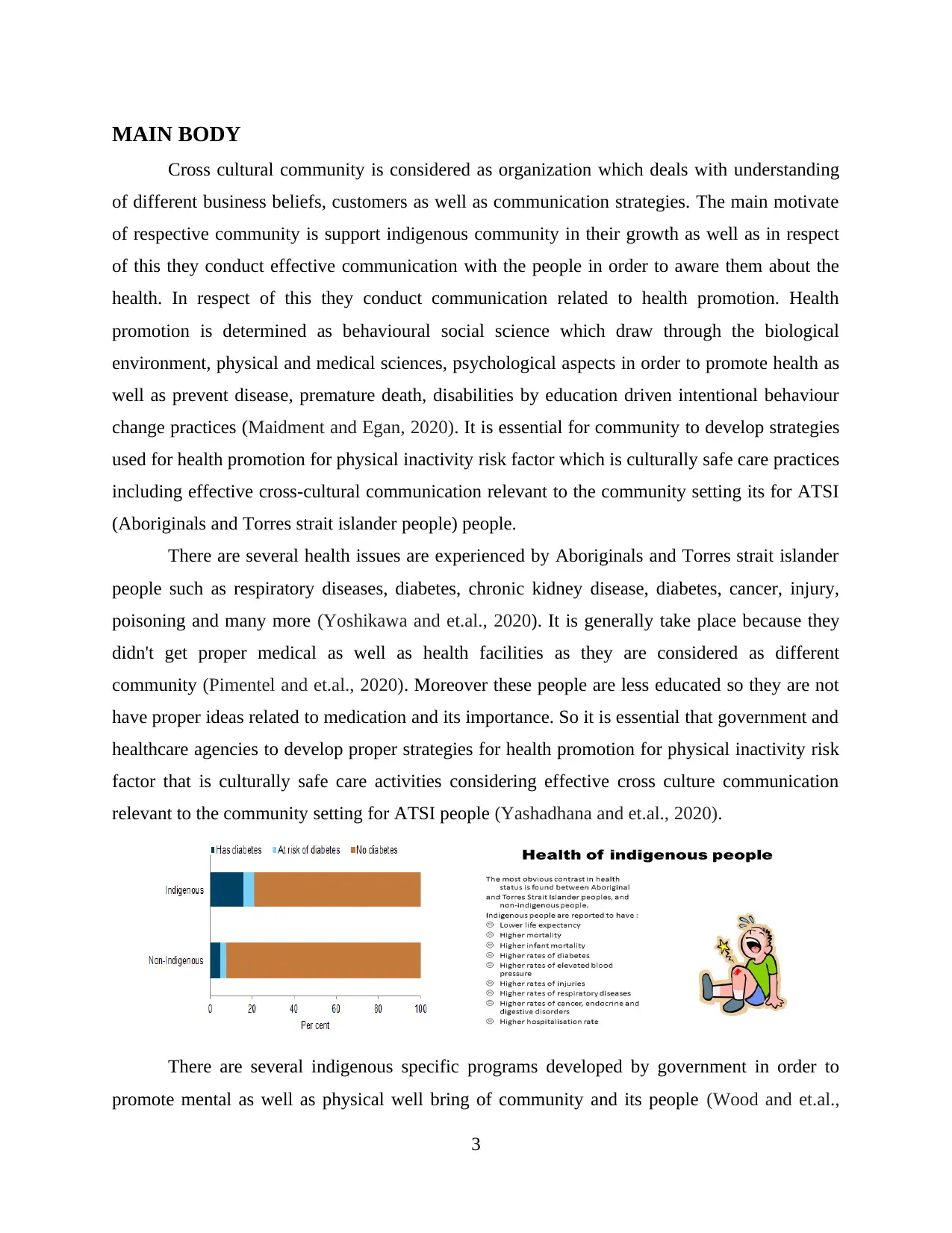
MAIN BODY
Cross cultural community is considered as organization which deals with understanding
of different business beliefs, customers as well as communication strategies. The main motivate
of respective community is support indigenous community in their growth as well as in respect
of this they conduct effective communication with the people in order to aware them about the
health. In respect of this they conduct communication related to health promotion. Health
promotion is determined as behavioural social science which draw through the biological
environment, physical and medical sciences, psychological aspects in order to promote health as
well as prevent disease, premature death, disabilities by education driven intentional behaviour
change practices (Maidment and Egan, 2020). It is essential for community to develop strategies
used for health promotion for physical inactivity risk factor which is culturally safe care practices
including effective cross-cultural communication relevant to the community setting its for ATSI
(Aboriginals and Torres strait islander people) people.
There are several health issues are experienced by Aboriginals and Torres strait islander
people such as respiratory diseases, diabetes, chronic kidney disease, diabetes, cancer, injury,
poisoning and many more (Yoshikawa and et.al., 2020). It is generally take place because they
didn't get proper medical as well as health facilities as they are considered as different
community (Pimentel and et.al., 2020). Moreover these people are less educated so they are not
have proper ideas related to medication and its importance. So it is essential that government and
healthcare agencies to develop proper strategies for health promotion for physical inactivity risk
factor that is culturally safe care activities considering effective cross culture communication
relevant to the community setting for ATSI people (Yashadhana and et.al., 2020).
There are several indigenous specific programs developed by government in order to
promote mental as well as physical well bring of community and its people (Wood and et.al.,
3
Cross cultural community is considered as organization which deals with understanding
of different business beliefs, customers as well as communication strategies. The main motivate
of respective community is support indigenous community in their growth as well as in respect
of this they conduct effective communication with the people in order to aware them about the
health. In respect of this they conduct communication related to health promotion. Health
promotion is determined as behavioural social science which draw through the biological
environment, physical and medical sciences, psychological aspects in order to promote health as
well as prevent disease, premature death, disabilities by education driven intentional behaviour
change practices (Maidment and Egan, 2020). It is essential for community to develop strategies
used for health promotion for physical inactivity risk factor which is culturally safe care practices
including effective cross-cultural communication relevant to the community setting its for ATSI
(Aboriginals and Torres strait islander people) people.
There are several health issues are experienced by Aboriginals and Torres strait islander
people such as respiratory diseases, diabetes, chronic kidney disease, diabetes, cancer, injury,
poisoning and many more (Yoshikawa and et.al., 2020). It is generally take place because they
didn't get proper medical as well as health facilities as they are considered as different
community (Pimentel and et.al., 2020). Moreover these people are less educated so they are not
have proper ideas related to medication and its importance. So it is essential that government and
healthcare agencies to develop proper strategies for health promotion for physical inactivity risk
factor that is culturally safe care activities considering effective cross culture communication
relevant to the community setting for ATSI people (Yashadhana and et.al., 2020).
There are several indigenous specific programs developed by government in order to
promote mental as well as physical well bring of community and its people (Wood and et.al.,
3
⊘ This is a preview!⊘
Do you want full access?
Subscribe today to unlock all pages.

Trusted by 1+ million students worldwide
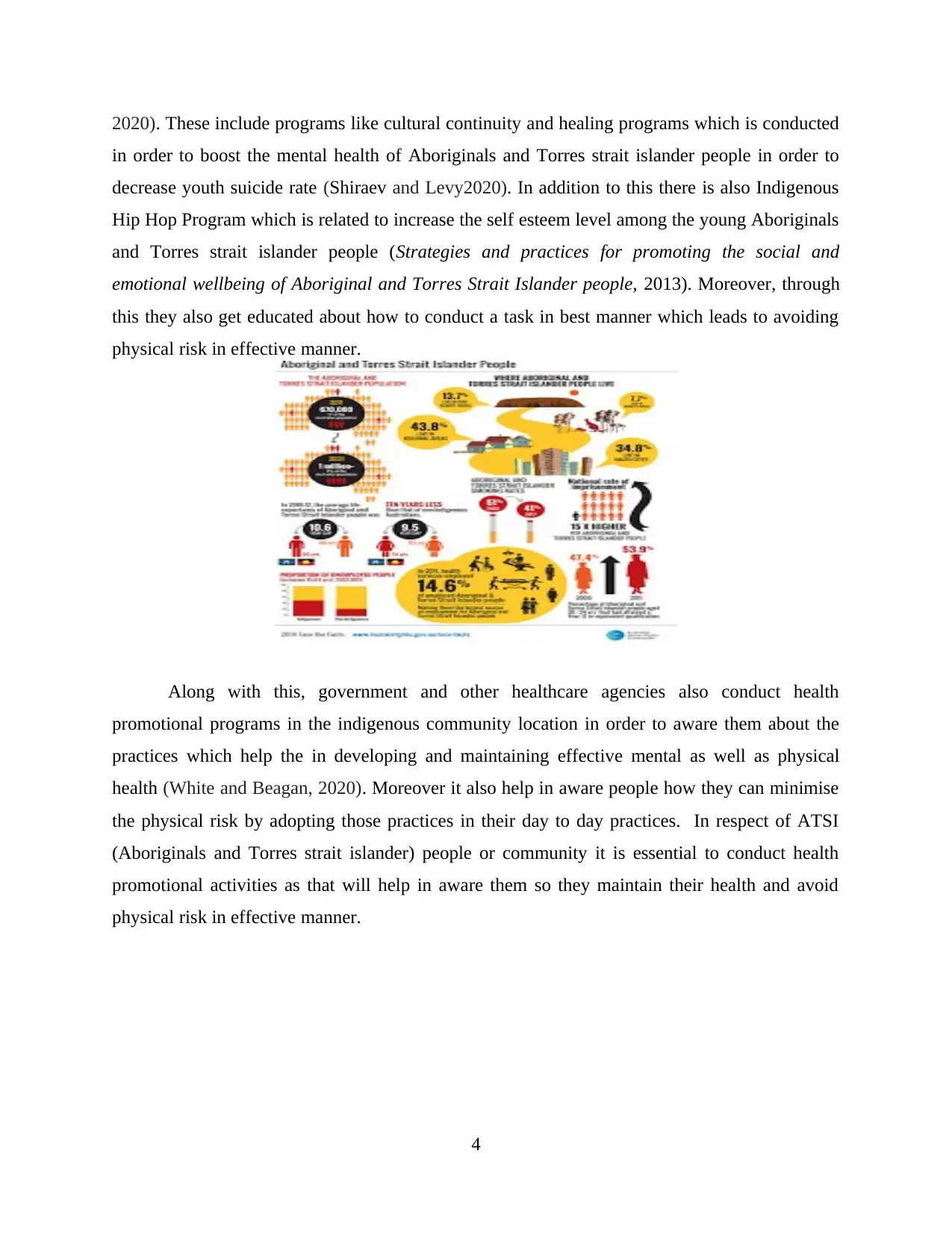
2020). These include programs like cultural continuity and healing programs which is conducted
in order to boost the mental health of Aboriginals and Torres strait islander people in order to
decrease youth suicide rate (Shiraev and Levy2020). In addition to this there is also Indigenous
Hip Hop Program which is related to increase the self esteem level among the young Aboriginals
and Torres strait islander people (Strategies and practices for promoting the social and
emotional wellbeing of Aboriginal and Torres Strait Islander people, 2013). Moreover, through
this they also get educated about how to conduct a task in best manner which leads to avoiding
physical risk in effective manner.
Along with this, government and other healthcare agencies also conduct health
promotional programs in the indigenous community location in order to aware them about the
practices which help the in developing and maintaining effective mental as well as physical
health (White and Beagan, 2020). Moreover it also help in aware people how they can minimise
the physical risk by adopting those practices in their day to day practices. In respect of ATSI
(Aboriginals and Torres strait islander) people or community it is essential to conduct health
promotional activities as that will help in aware them so they maintain their health and avoid
physical risk in effective manner.
4
in order to boost the mental health of Aboriginals and Torres strait islander people in order to
decrease youth suicide rate (Shiraev and Levy2020). In addition to this there is also Indigenous
Hip Hop Program which is related to increase the self esteem level among the young Aboriginals
and Torres strait islander people (Strategies and practices for promoting the social and
emotional wellbeing of Aboriginal and Torres Strait Islander people, 2013). Moreover, through
this they also get educated about how to conduct a task in best manner which leads to avoiding
physical risk in effective manner.
Along with this, government and other healthcare agencies also conduct health
promotional programs in the indigenous community location in order to aware them about the
practices which help the in developing and maintaining effective mental as well as physical
health (White and Beagan, 2020). Moreover it also help in aware people how they can minimise
the physical risk by adopting those practices in their day to day practices. In respect of ATSI
(Aboriginals and Torres strait islander) people or community it is essential to conduct health
promotional activities as that will help in aware them so they maintain their health and avoid
physical risk in effective manner.
4
Paraphrase This Document
Need a fresh take? Get an instant paraphrase of this document with our AI Paraphraser
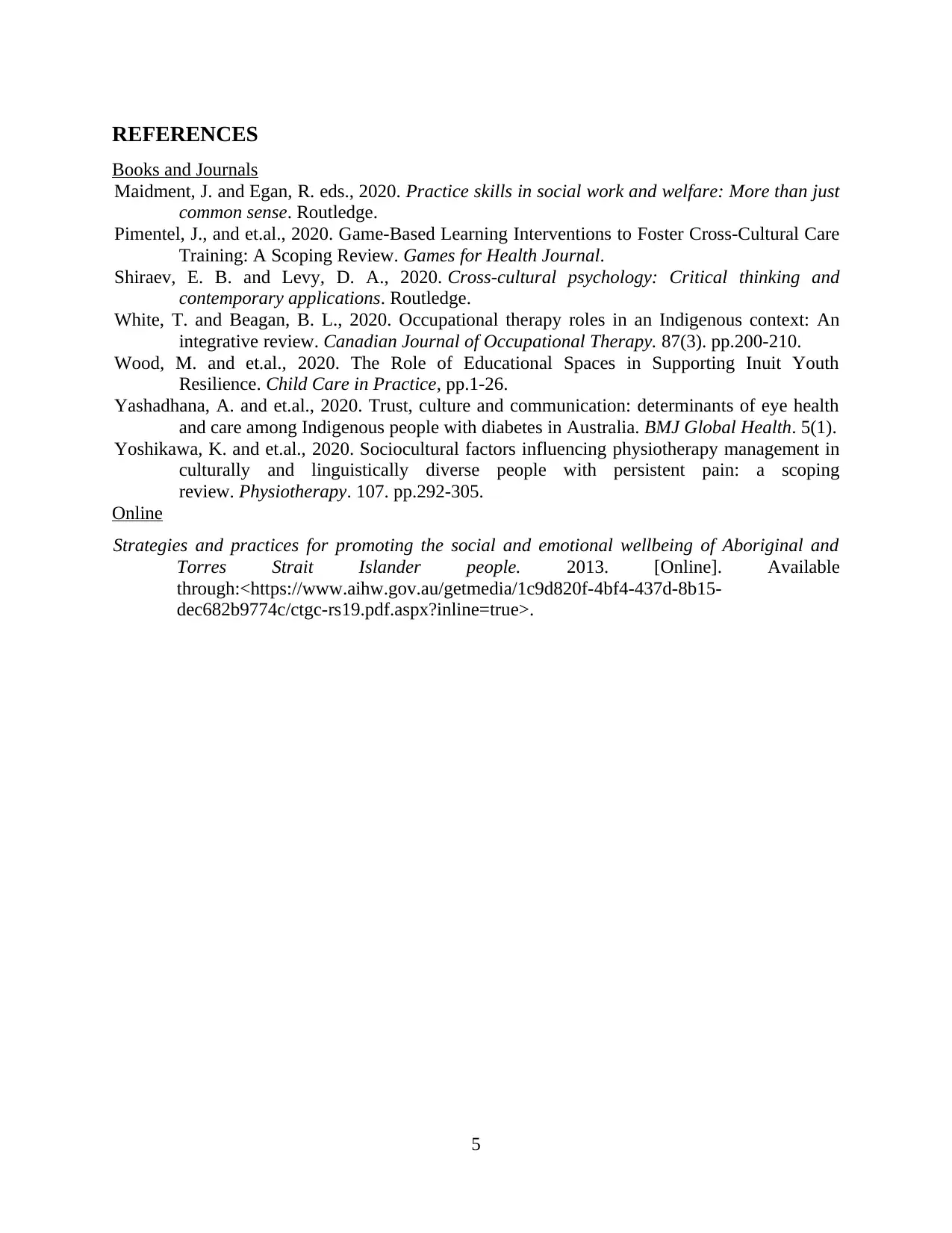
REFERENCES
Books and Journals
Maidment, J. and Egan, R. eds., 2020. Practice skills in social work and welfare: More than just
common sense. Routledge.
Pimentel, J., and et.al., 2020. Game-Based Learning Interventions to Foster Cross-Cultural Care
Training: A Scoping Review. Games for Health Journal.
Shiraev, E. B. and Levy, D. A., 2020. Cross-cultural psychology: Critical thinking and
contemporary applications. Routledge.
White, T. and Beagan, B. L., 2020. Occupational therapy roles in an Indigenous context: An
integrative review. Canadian Journal of Occupational Therapy. 87(3). pp.200-210.
Wood, M. and et.al., 2020. The Role of Educational Spaces in Supporting Inuit Youth
Resilience. Child Care in Practice, pp.1-26.
Yashadhana, A. and et.al., 2020. Trust, culture and communication: determinants of eye health
and care among Indigenous people with diabetes in Australia. BMJ Global Health. 5(1).
Yoshikawa, K. and et.al., 2020. Sociocultural factors influencing physiotherapy management in
culturally and linguistically diverse people with persistent pain: a scoping
review. Physiotherapy. 107. pp.292-305.
Online
Strategies and practices for promoting the social and emotional wellbeing of Aboriginal and
Torres Strait Islander people. 2013. [Online]. Available
through:<https://www.aihw.gov.au/getmedia/1c9d820f-4bf4-437d-8b15-
dec682b9774c/ctgc-rs19.pdf.aspx?inline=true>.
5
Books and Journals
Maidment, J. and Egan, R. eds., 2020. Practice skills in social work and welfare: More than just
common sense. Routledge.
Pimentel, J., and et.al., 2020. Game-Based Learning Interventions to Foster Cross-Cultural Care
Training: A Scoping Review. Games for Health Journal.
Shiraev, E. B. and Levy, D. A., 2020. Cross-cultural psychology: Critical thinking and
contemporary applications. Routledge.
White, T. and Beagan, B. L., 2020. Occupational therapy roles in an Indigenous context: An
integrative review. Canadian Journal of Occupational Therapy. 87(3). pp.200-210.
Wood, M. and et.al., 2020. The Role of Educational Spaces in Supporting Inuit Youth
Resilience. Child Care in Practice, pp.1-26.
Yashadhana, A. and et.al., 2020. Trust, culture and communication: determinants of eye health
and care among Indigenous people with diabetes in Australia. BMJ Global Health. 5(1).
Yoshikawa, K. and et.al., 2020. Sociocultural factors influencing physiotherapy management in
culturally and linguistically diverse people with persistent pain: a scoping
review. Physiotherapy. 107. pp.292-305.
Online
Strategies and practices for promoting the social and emotional wellbeing of Aboriginal and
Torres Strait Islander people. 2013. [Online]. Available
through:<https://www.aihw.gov.au/getmedia/1c9d820f-4bf4-437d-8b15-
dec682b9774c/ctgc-rs19.pdf.aspx?inline=true>.
5
1 out of 5
Related Documents
Your All-in-One AI-Powered Toolkit for Academic Success.
+13062052269
info@desklib.com
Available 24*7 on WhatsApp / Email
![[object Object]](/_next/static/media/star-bottom.7253800d.svg)
Unlock your academic potential
Copyright © 2020–2025 A2Z Services. All Rights Reserved. Developed and managed by ZUCOL.




